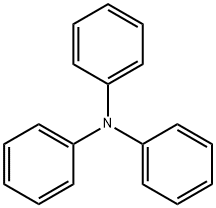| Identification | More | [Name]
Triphenylamine | [CAS]
603-34-9 | [Synonyms]
N,N-DIPHENYLANILINE
N,N-diphenylbenzenamine
TRIPHENYLAMINE
amine,triphenyl
N,N,N-Triphenylamine
n,n-diphenyl-benzenamin
Triphenylamin
Triphenylamine99+%
Triphenylamine,98%
Benzenamine, N,N-diphenyl-
Triphenylamine (TPA) | [EINECS(EC#)]
210-035-5 | [Molecular Formula]
C18H15N | [MDL Number]
MFCD00003020 | [Molecular Weight]
245.32 | [MOL File]
603-34-9.mol |
| Chemical Properties | Back Directory | [Appearance]
Triphenylamine is a colorless crystalline solid. | [Melting point ]
124-128 °C (lit.) | [Boiling point ]
347-348 °C (lit.) | [density ]
0.7740 | [refractive index ]
1.3530 (estimate) | [Fp ]
365°C | [storage temp. ]
Sealed in dry,Room Temperature | [solubility ]
Chloroform (Slightly) | [form ]
Crystalline Powder | [pka]
-3.04±0.30(Predicted) | [color ]
Off-white to slightly beige | [Stability:]
Stable. Combustible. Incompatible with strong oxidizing agents. | [Water Solubility ]
insoluble | [Detection Methods]
HPLC | [BRN ]
2050487 | [Exposure limits]
NIOSH: TWA 5 mg/m3 | [CAS DataBase Reference]
603-34-9(CAS DataBase Reference) | [NIST Chemistry Reference]
Benzenamine, N,N-diphenyl-(603-34-9) | [EPA Substance Registry System]
603-34-9(EPA Substance) |
| Safety Data | Back Directory | [Hazard Codes ]
Xi | [Risk Statements ]
R36/38:Irritating to eyes and skin .
R36/37/38:Irritating to eyes, respiratory system and skin . | [Safety Statements ]
S26:In case of contact with eyes, rinse immediately with plenty of water and seek medical advice .
S28:After contact with skin, wash immediately with plenty of ... (to be specified by the manufacturer) .
S37/39:Wear suitable gloves and eye/face protection . | [OEB]
B | [OEL]
TWA: 5 mg/m3 | [WGK Germany ]
2
| [RTECS ]
YK2680000
| [Hazard Note ]
Irritant | [TSCA ]
Yes | [HS Code ]
29214980 | [Safety Profile]
Moderately toxic by
ingestion. When heated to decomposition it
emits toxic fumes of NOx. See also
AROMATIC AMINES. | [Hazardous Substances Data]
603-34-9(Hazardous Substances Data) |
| Raw materials And Preparation Products | Back Directory | [Preparation Products]
4,4'-DIFORMYLTRIPHENYLAMINE-->Benzenamine, 4-iodo-N-(4-iodophenyl)-N-phenyl--->Tris(4-iodophenyl)amine-->4-Fluoro-N,N-diphenylbenzenamine-->N-PHENYLCARBAZOLE HYDROCHLORIDE-->N-(4-IODOPHENYL)-N-PHENYLBENZENAMINE-->N,N-Diphenyl-4-(4,4,5,5-tetramethyl-1,3,2-dioxaborolan-2-yl)aniline-->TAPA-->N-(4-BroMophenyl)-N,N-bis(1,1'-biphenyl-4-yl)aMine-->Benzoic acid, 4,4'-(phenylimino)bis- |
| Hazard Information | Back Directory | [General Description]
Crystals or off-white lumpy solid. | [Reactivity Profile]
TRIPHENYLAMINE(603-34-9) neutralizes acids in exothermic reactions to form salts plus water. May be incompatible with isocyanates, halogenated organics, peroxides, phenols (acidic), epoxides, anhydrides, and acid halides. Flammable gaseous hydrogen may be generated in combination with strong reducing agents, such as hydrides. | [Air & Water Reactions]
Insoluble in water. | [Potential Exposure]
Triphenylamine is used as a primary
photoconductor and in making photographic film coated on
photographic film bases. | [Fire Hazard]
The flash point of this chemical has not been determined, but TRIPHENYLAMINE is probably combustible. | [First aid]
Skin Contact: Flood all areas of body that
have contacted the substance with water. Don’t wait to
remove contaminated clothing; do it under the water
stream. Use soap to help assure removal. Isolate contaminated
clothing when removed to prevent contact by others.
Eye Contact: Remove any contact lenses at once.
Immediately flush eyes well with copious quantities of
water or normal saline for at least 20-30 minutes. Seek
medical attention. Inhalation: Leave contaminated area
immediately; breathe fresh air. Proper respiratory protection
must be supplied to any rescuers. If coughing, difficult
breathing or any other symptoms develop, seek medical
attention at once, even if symptoms develop many hours
after exposure. Ingestion: Contact a physician, hospital or
poison center at once. If the victim is unconscious or convulsing,
do not induce vomiting or give anything by mouth.
Assure that the patient’s airway is open and lay him on his
side with his head lower than his body and transport immediately
to a medical facility. If conscious and not convulsing,
give a glass of water to dilute the substance. Vomiting
should not be induced without a physician’s advice. | [Incompatibilities]
Incompatible with oxidizers (chlorates,
nitrates, peroxides, permanganates, perchlorates, chlorine,
bromine, fluorine, etc.); contact may cause fires or explosions.
Keep away from alkaline materials, strong bases,
strong acids, oxo acids, epoxides, aldehydes, ketones. | [Chemical Properties]
Monoclinic crystals from EtOAc. | [Chemical Properties]
Triphenylamine is a colorless crystalline solid. | [Synthesis Reference(s)]
Canadian Journal of Chemistry, 61, p. 86, 1983 DOI: 10.1139/v83-015
Organic Syntheses, Coll. Vol. 1, p. 544, 1941 | [Health Hazard]
Triphenyl amine is considered
to have low systemic toxicity, but it may act as
a slight skin irritant.
Adverse effects have not been reported in
humans. | [Carcinogenicity]
Triphenyl amine was not mutagenic in
bacterial assays with or without metabolic
activation. | [Purification Methods]
Crystallise the amine from EtOH or from *benzene/absolute EtOH, diethyl ether and pet ether. It is sublimed under vacuum and carefully dried in a vacuum line. Store it in the dark under nitrogen. [Beilstein 12 IV 276.] |
| Questions and Answers (Q&A) | Back Directory | [Uses]
Organic light-emitting diode (OLED) devices have received much attention, because they are expected to be a next generation display and light source, thanks to lightweight and flexible organic materials.
- Triphenylamine is a propeller-like structural chromophore with a nitrogen atom center. The compound has a large steric hindrance and hyper conjugation electronic effect, which can enhance the stability of the nitrogen atomic radical. Triphenylamine materials also have a high hole mobility due to their unique free radicals nature. Many hole transport materials based on triphenylamine derivatives (TPD) are widely usable,because they are heat-resistant and amorphous.In addition to the TPDs, oxadiazole derivatives (PBD) having an electron transport property, Alq3 as a host material,and blue emissive distylyl derivatives are fundamental materials for amorphous OLED devices.
- It is used in the manufacture of photographic film.
- Triphenylamines (TPAs) are highly fluorescent compounds that are efficient to induce cell death upon visible light excitation.
- Triphenylamine is used in organic light-emitting diode as hole-transporters and as a pharmaceutical intermediate.
- It is coated on film bases as primary photoconductor.
|
|
|





